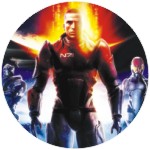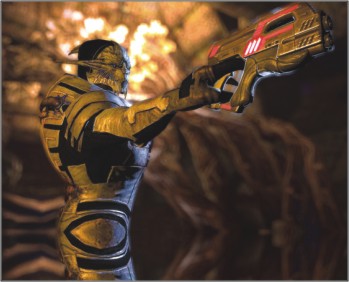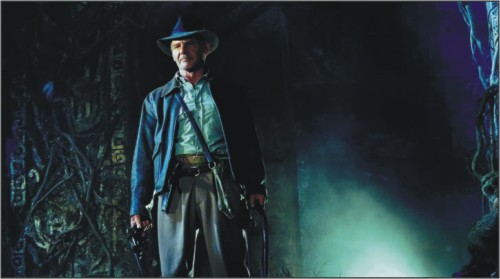
 Continued from last week
Continued from last week
Robots cannot easily mimic the motion of walking. With a robot, there is a direct command (lift leg 'x' amount, lean forward 'y' amount, extend leg downward 'z' amount, and so on). With humans, however, there is no 'feedback' mechanism - your brain does not constantly communicate to your legs on where to be placed. Instead, you simply lean forward and 'fall,' setting your leg to absorb the shock when your foot makes contact with the floor.
So it's not likely that we could see a working Optimus Prime or robot like him in our lifetimes. But robots that can change their shape or become any shape already exist. We'll look at some of them - and how they compare to Prime - in the next section.
Self-Reconfiguring Robots
The coolest thing about Transformers, of course, is that they can take two completely different shapes. Most can be bipedal robots or working vehicles. Some can instead transform into weapons or electronic devices. A Transformer's two forms have vastly different strengths and capabilities.
This is completely different from most real robots, which are usually only good at performing one task or a few related tasks. The Mars Exploration Rovers, for example, can generate power with solar cells and store it in batteries, drive across the landscape, take pictures, drill into rocks and so on.

An Exploration Rover wouldn't be very good at tasks that don't fit into these categories. It can't, for example, assemble a bridge, fit into very small spaces or build other robots. In other words, it would make a lousy search-and-rescue robot, and it wouldn't fit in at all in an automated factory.
That's why engineers are developing reconfiguring robots. Like Transformers, these robots can change their shape to fit the task at hand. But instead of changing from one shape to one other shape, like a bipedal robot to a tractor-trailer, reconfiguring robots can take many shapes. They're much smaller than real Transformers would be; some reconfiguring robot modules are small enough to fit in a person's hand.
A module is essentially a small, relatively simple robot or piece of a robot. Modular robots are made of lots of these small, identical modules. A modular robot can consist of a few modules or many, depending on the robot's design and the task it needs to perform. Some modular robots currently exist only as computer simulations; others are still in the early stages of development. But they all operate on the same basic principle - lots of little robots can combine to create one big one.
Most modular, reconfiguring robots fit into one of three categories: chain, lattice and modular configuration. Chain robots are long chains that can connect to one another at specific points. Depending on the number of chains and where they connect, these robots can resemble snakes or spiders. They can also become rolling loops or bipedal, walking robots. A set of modular chains could navigate an obstacle course by crawling through a tunnel as a snake, crossing rocky terrain as a spider and riding a tricycle across a bridge as a biped.
Examples of chain robots are Palo Alto Research Center's (PARC) Polybot and Polypod and NASA's Snakebot. Most need a human or, in theory, another robot, to manually secure the connections with screws.
Lattice Robots
The basic idea of a lattice robot is that swarms of small, identical modules that can combine to form a larger robot. Several prototype lattice robots already exist, but some models exist only as computer simulations. Lattice robots move by crawling over one another, attaching to and detaching from connection points on neighboring robots. It's like the way the tiles move in a sliding tile puzzle. This method of movement is called substrate reconfiguration the robots can move only along points within the lattice of robots. Lattice modules can either have self-contained power sources, or they can share power sources through their connections to other modules.
Simulated Robots
Computer simulations are a vital part of robotics research, particularly with reconfiguring robots. Scientists use computers to figure out how modules will move in relation to one another before teaching the modules how to do so. In some cases, computer simulations exist long before actual robots. The Massachusetts Institute of Technology (MIT) Rus Robotics Laboratory has numerous simulations of how these robots move around.
Lattice robots can move over difficult terrain by climbing over one another, following the shape of the terrain, or they can form a solid, stable surface to support other structures. Enough lattice robots can create just about any shape. Computer simulations show them changing from a pile of parts to a teacup and from a dog to a couch. The modules can combine to make flat surfaces, ladders, movable appendages and virtually any other imaginable shape. So a lattice robot is more like a Terminator T-1000 than a Transformer.
Like lattice robots, mobile reconfiguration robots are small, identical modules that can combine to form bigger robots. However, they don't need their neighbors' help to get from place to place they can move around on their own. Mobile configuration robots are a lot like cartoon depictions of schools of fish or flocks of birds that combine to create a tool or structure. They move independently until they need to come together to accomplish a specific task. Swarm-bots, a project by the Future and Emerging Technologies program in the European Union, are mobile reconfiguration robots.
Even though these robots look very different from one another, they have many similarities in how they move and operate.
A Really Real Transformer
Transformers aren't necessarily practical or even possible on a large scale. But engineers at Himeji Soft Works have developed a small-scale robot that really turns from a car to a biped and back. You can see a video of this robot, including its transformation, at YouTube.
A Swarm of Parallel Brains
Transformers are self-aware and can make decisions on their own, but their moving parts aren't autonomous. In addition to their size and modular structure, self-reconfiguring robots are different from Transformers in one major way. Optimus Prime and other Transformers are self-aware and can make independent decisions, and they keep their brains in one location within their bodies. A Transformer's brain controls each of its moving parts, and the parts themselves have little if any autonomy.
In most modular robot configurations, though, each module has some decision-making power and gets to help figure out where it's going to move. Instead of one module being the boss of all the others, planning and movement capabilities are distributed across all of the modules.
This idea -- a swarm of little robots, each of which gets to decide where it's going to go -- might sound disastrous. But the modules are programmed with a set of geometry-based rules about how to move. They're also programmed with algorithms that govern their movement. These algorithms and rules allow the robots to figure out how to change from one shape into another and to move across terrain.
For very complex maneuvers, the robots instead plan out a series of sub-shapes rather than trying to make a major change in one step. For example, a lattice robot that needs to change from a random pile of modules to a bipedal robot might first form the legs. Then, it might use those legs as a scaffold to build the upper half of the robot.
Even though these robots don't walk and talk like Transformers do, they can change into virtually any shape, given the right programming and instructions. But real transformers are still a long way into the future.
Source: HowStuffWorks.com

By beb-E
 Minimum Requirements:
Minimum Requirements:
Processor: 2.4GHz Intel or 2.0GHz AMD (single core)
Memory: 1GB (XP) or 2GB (Vista)
HDD: 10 GB free space
Graphics card: nVidia 6800GT or ATI X1300 or better.
Reviewer's computer:
Processor: Core 2 Duo 2.4GHz
Memory: 8 GB
Graphics card: nVidia 8800GS
Since the 28th of May, this casual gamer has been on the literal edge at the tip of his feet, flinching at every DVD store in his way, kicking for that one damned game- Mass Effect.
ince the 28th of May, this casual gamer has been on the literal edge at the tip of his feet, flinching at every DVD store in his way, kicking for that one damned game- Mass Effect.
Mass Effect, from my favorite developer BioWare, was released on around the 20th of November on the Xbox 360. And sometime soon after that, it was announced to be released on PC, similar to style as with other BioWare games Star Wars - Knights of the Old Republic and Jade Empire.
 Story: Human kind found Luna on the moon, the first space colony, in the year 2069, 100 years after the first lunar landing. In the year 2148, the first alien technology is uncovered on Mars, of an extinct civilization called Prothean. This technology puts them ahead two hundred years of progress, allowing for galactic travel, using the mysterious 'dark energy' that manipulates the very fabric of space and time itself. And this is the Mass Effect. The current year is 2183, and you play as Commander Shepard struggling to become the first human Spectre in the council. A mission goes awry, and you realize that the entire galaxy is threatened to extinction from the Geth (synthetic beings) under a corrupt council member, and it falls on your shoulders to convince the Citadel Council of such sedition, against all odds. Making this even difficult is the fact that you're human, and no one trusts you.
Story: Human kind found Luna on the moon, the first space colony, in the year 2069, 100 years after the first lunar landing. In the year 2148, the first alien technology is uncovered on Mars, of an extinct civilization called Prothean. This technology puts them ahead two hundred years of progress, allowing for galactic travel, using the mysterious 'dark energy' that manipulates the very fabric of space and time itself. And this is the Mass Effect. The current year is 2183, and you play as Commander Shepard struggling to become the first human Spectre in the council. A mission goes awry, and you realize that the entire galaxy is threatened to extinction from the Geth (synthetic beings) under a corrupt council member, and it falls on your shoulders to convince the Citadel Council of such sedition, against all odds. Making this even difficult is the fact that you're human, and no one trusts you.
Visuals: The graphics are naturally quite good and one expects no less from the developers with today's trend of gaming realism. Quite a fine addition to the already superb graphics is the “Film Grain” effect, which if enabled gives the game a very classy, glassy and slightly hazy, albeit cool look. The conversations too are rather more cinematic, using objects blurring and focusing techniques- effects blended in to make it seem like a movie. This is not always pulled off very neatly, however. One more thing- the shadows were quite horrible.

Sounds: Whenever I took a single step, I heard the sound of three. This could be the fault of my on-board audio, and I really hope it is. Very annoyingly, most of the voice acting were very dull and emotionless, particularly that of the male protagonist, which makes you wonder if this Shepard dude is mental. A lot of NPC's are well-spoken, though and if you choose to play as female, you'll be greeted by an infinitely better voice, played by the veteran Jennifer Hale. The soundtrack of Mass Effect, though isn't to die for, is quite good, with an obvious sci-fi feel to it, providing a good ambience to the entire galactic atmosphere. Play with a female character, if you don't want to be annoyed at every conversation.
Gameplay: A mix between a third-person shooter and a role-playing game, I never thought that BioWare would do shooters, but there you go, then.
Takes all kind to make the world. You have at your disposal, along with armors, four basic types of weapons- assault rifles, shotguns, snipers and my recent favorite type, pistols. You can find different sorts of guns of variable usefulness, all of which can be upgraded through slots. There're Tech abilities, which are support powers and then there's Biotics, implants enhancing someone's natural abilities to manipulate the dark energy. It's a squad-based game, and learning to control and order your team mates will be a very crucial part of survival.
Unlike BioWare's previous games where the dialogues (choices) were more… there, Mass Effect utilizes a 'wheel', where the top spokes indicate a 'good-side' choice, bottom spokes for 'bad-side', and the immediate left and right the default ones, which kind of makes everything slightly bland. The character doesn't even say the exact words from the spokes, which gets annoying, too. Bit of a departure from BioWare's previous works. And (male) Shepard's monotonous tones don't make the dialogues any more there, either. Conclusion: This was one of the most hyped about game of last year and this, all for the right reasons. A very expansive and huge game, it takes you from one edge of the galaxy to the next, letting you explore a vast and imaginative universe filled with wonders, populated by countless alien races and bright burning stars. It will remind you often of old timer science fictions, such as Battlestar Galactica, Blade Runner, Star Trek or Star Wars. And this epic adventure is certain to give you something back, something to remember it by, on a lonely cold winter morning.
It isn't without its flaws, though, as have been pointed out. A lot of trivial annoyances just stack up, Details such as voiceovers help to make the whole gaming experience all the more immersing. And everytime you get into a conversation, the immersion is axed away from you by the robotic John Shepard. In fact, the robots are more interesting.
If you expect, you get disappointed. I suppose I should have set my standards a little lower, but then I thought, “It's BioWare.” Yet, in the end, they are, after all, ultimately human. Regardless of everything, it still should be worth your time, and by no means would I suggest anyone not to play it.

 The new Indy movie is not as good as “Raiders of the Lost Ark.” But that doesn't make it bad. So stop comparing and complaining.
The new Indy movie is not as good as “Raiders of the Lost Ark.” But that doesn't make it bad. So stop comparing and complaining.
Instead, Steven Spielberg's “Indiana Jones and the Kingdom of the Crystal Skull” is merely grand old-school fun a rollicking class reunion that stands as the second best entry in the venerable series. The new movie has more fun elements the last two sequels.
The emphasis in “Crystal Skull” is on old-fashioned stuntwork rather than the shiny chimeras of modern digital effects. When Indiana Jones (Harrison Ford) catapults from the back of a motorcycle through the window of a speeding car, out the opposite window and back onto the motorcycle his feet nervously skitching along the roadbed at least half the excitement is knowing that motorcycle, car, Ford, and road are real.
Character and star may have aged two decades since the last installment, but bullets still miss the good guys with astonishing regularity, and Indiana Jones may be the only person who could escape a desert nuclear test site with an A-bomb due to land in ten seconds. How he manages this makes no blessed sense, but it's a hoot anyway. The fun of Indiana Jones is in how luck favours him so much.
 The plot:
The plot:
The time is 1957 and the enemies are Russian Communists mankind is at stake. Again! Indy as a believably older but still absurdly capable figure along with Cate Blanchett as Irina Spalko who is a Red menace with a sword.
The plot of “Crystal Skull” requires dancing around a number of spoilers so we will try to leave out as much as possible.
What Spalko and her KGB minions are after is a rare and very strange crystal skull that legends say was stolen from El Dorado, the lost city of gold in Peru. One of Indiana's colleagues, Professor Oxley (John Hurt), has set out to find it and disappeared, and a young man named Mutt (Shia LeBeouf) arrives to beg Jones to rescue his old friend.
The movie has lengthy and delightful chase scenes such as one involving Mutt and Indy on a motorcycle careen through the college campus (inside the library and out) with Russians in high-speed pursuit is an early high point.

It's wonderful, for instance, to see Karen Allen reprise her role as Marion Ravenwood from
“Raiders,” since her warmth was precisely what was missing from the first two sequels.
The rest of the cast keeps pace Ray Winstone as an accomplice who may or may not be a betrayer, Jim Broadbent taking over for the late Denholm Elliott as Indy's college friend. LeBoeuf has an interesting alertness that he still hasn't figured out how to use as an actor, but he throws himself into the stuntwork like a proper student at the feet of the masters.
The movie offers nostalgia for those old enough to be wowed by the originals back then and a sense of wonderment for the young 'uns. Some will hate it, others won't. But watch this movie for the fun and humour and the action. Forget logic when you need to enjoy a movie.
